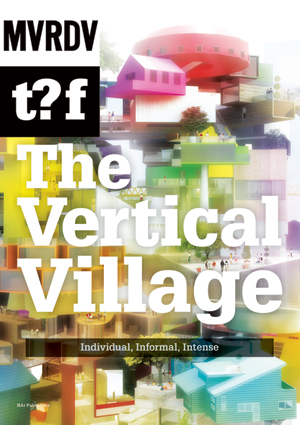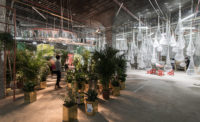The Vertical Village: Individual, Informal, Intense, edited by Winy Maas. NAi Publishers: 2012, 528 pages, $45.
How the City Moved to Mr. Sun: China’s New Megacities, by Michiel Hulshof and Daan Roggeveen. SUN Publishers: 2011, 392 pages, $51.
How the City Moved to Mr. Sun: China’s New Megacities, by Michiel Hulshof and Daan Roggeveen. SUN Publishers: 2011, 392 pages, $51.
Two new books take on the complex and timely topic of contemporary urbanism in Asia. Coincidentally (or not) written by Dutch teams, The Vertical Village and How the City Moved to Mr. Sun are both smart and stunning. Like good urban planning, they are well conceived, thoroughly researched, and beautifully designed. And while two new books on one topic may seem one too many, their radically different points of view—one utopian, the other journalistic—make them both necessary reads.


The Vertical Village is a collaborative research project led by architect and urbanist Winy Maas, his firm MVRDV, and his think tank the Why Factory, with participants from several Dutch and Taiwanese universities. Maas’s utopian vision aims to replace the residential tower in the sky (the 20th-century’s utopian vision) with a high-rise village, which he defines as “a vertical stack of low-rise, individual homes and amenities.” This idea of flexible, expandable housing is not exactly radical; works by Archigram and the Metabolists come to mind. What is new is the context—major Asian cities where traditional urban villages are being replaced (or already have been replaced) by towers.
The book’s 14 chapters include an introduction to what its authors dub the “block attack” of tower residences, mappings of tower infiltration in nine Asian cities (Beijing, Seoul, Tokyo, Shanghai, Taipei, Hong Kong, Bangkok, Singapore, and Jakarta), examples of low-rise holdouts to these blocks, screenshots of software for do-it-yourself house and village design, and both abstract and site-specific student-designed models of vertical villages.
The proposal is unabashedly idealistic. When asked about the market practicality of the vertical village, Maas responded, “We probably need to first invent a new infrastructure. Like a sky car. ... And another financial system.” Still, the project is well rooted in data. Clear and consistent maps and charts; explorations of the effects of energy, economy, and structure on the model; and interviews with experts on its feasibility make the vertical village seem almost buildable.
One weakness stands out: The book contains a limited number of voices from its region of study. Hsinyao Huang’s interviews with house hunters and Yen-Fen Tseng’s discussion of high-rise social interaction give the reader a glimpse into Taiwanese ideas of individuality and community, use of outdoor space, and home as a place of refuge rather than socialization. Additional voices from other Asian locations would help balance some of the book’s Eurocentrism, such as its romanticization of traditional urban conditions. I am curious to hear what an Indonesian writer might have to say about the proposal to develop a vertical village around a Jakarta garbage-picking slum.
The local voices missing from The Vertical Village play a significant role in How the City Moved to Mr. Sun. This study of urbanism in China is informed by interviews with those affected by it. The country’s coastal development has been well documented in books like Thomas Campanella’s The Concrete Dragon and John Friedmann’s China’s Urban Transition, but here journalist Michiel Hulshof and architect Daan Roggeveen discuss 13 inland cities, the of-the-moment centers of China’s urban growth. A chapter on Shijiazhuang relates how the farmer Mr. Sun of the book’s title helped create “a village in the city” (not dissimilar to Maas’s vertical village) in the wake of the budding metropolis. Other chapters recount the stories of people involved in a central business district cut-and-pasted from multiple design proposals and in a neighborhood-development project that changed from historic preservation to recreation. The book also presents housing trends for China’s superrich and super-poor, and information on government assistance in establishing artists’ enclaves.
These tales are presented within a broader study of Chinese urbanism. The authors take on subjects that include the historical creation of cities, the Special Economic Zones established by Deng Xiaoping, and the effects of the hukou (residency) system on migration and education. A fascinating section in the chapter on the city of Xi’an traces the progression of a housing model from sixth-century imperial fang to 1950s communist danwei to contemporary gated compounds. All of this is set in language that is a delight to read. On one page, the authors seamlessly segue from Zhengzhou’s Go West development policy to Village People’s Go West disco hit to the classic Chinese novel Journey to the West.
A couple of choices in the book seem off target, though. Most photos do not have captions, which I assume was a design decision. Many are self explanatory, but many more would benefit from descriptions. And the conclusion of the book, tucked into the final chapter on Kashgar, skips the specificity that makes the rest of the texts so strong, in favor of overarching statements. Sentences like “Press freedom and freedom of opinion stretch only to the extent permitted by the Ministry of Propaganda” are not exactly enlightening.
But these weaknesses and those in The Vertical Village are minor points in otherwise winning publications. The importance of their topic—the rapid growth of Asian cities—cannot be underestimated. And whether considered through the designs of visionaries or the chronicles of realists, these books offer the context for contemplation.


Post a comment to this article
Report Abusive Comment